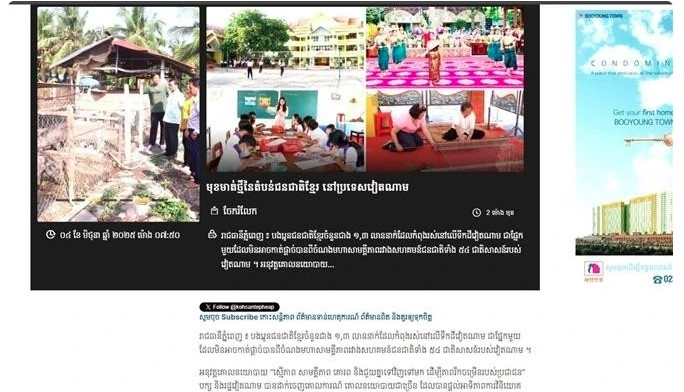Cambodian media praises thriving southern Khmer communities in Mekong Delta
A series of articles in the Cambodian media have highlighted the vibrant lives and transformative progress of Khmer communities in Vietnam’s Mekong Delta, showcasing their integration and development within the broader Vietnamese society.

Reports published in early June by Cambodian outlets stressed that the Khmer, numbering over 1.3 million, are a vital part of Vietnam’s 54 ethnic groups, united under the country’s commitment to national unity. The Vietnamese Party and State have introduced numerous policies and guidelines to prioritise the development of ethnic minority regions, with special attention to the Khmer community.
An article published on June 4 by the online edition of Koh Santepheap Daily, one of Cambodia’s oldest newspapers, detailed progress in Tra Vinh province, where more than 390,000 Khmer people make up about 31% of the local population.
It said the Vietnam’s national target programme for socio-economic development in ethnic minority and mountainous areas for 2021–2025 led to the construction of over 200 rural transportation works to support production, trade, and daily life as of late 2024. All local communes have overcome extreme difficulties, with over 1,100 ethnic minority households receiving housing and land assistance and nearly 1,700 others benefiting from job and vocational training courses. Paved inter-village and inter-commune roads have improved access to markets and schools, opening up opportunities for Khmer residents, particularly children.
In a related article, the Looking Today news site of DAP News provided an introduction of Soc Trang province, adjacent to Tra Vinh province across the Hau River. Boasting around 400,000 Khmer people, or over 30% of its population, Soc Trang has the highest concentration of Khmer residents among Mekong Delta localities.
The article quoted Lam Hoang Mau, Director of the provincial Department of Ethnic and Religious Affairs as saying that from 2020 to 2025, the provincial Party Committee and People’s Committee have made significant investments in socio-economic infrastructure to improve the living standards and production capacity of the Khmer communities. Over VND327 billion (US$12.5 million) has been allocated to build more than 400 infrastructure projects, including irrigation systems, rural roads, community centres, and the maintenance of public welfare facilities.
It also cited Lam Van Man, Secretary of the provincial Party Committee, who reaffirmed the province’s commitment to further infrastructure development and cultural investment in ethnic minority areas. He stressed the need to mobilise resources to enhance socio-economic development and to scale up successful poverty reduction models.
The province is striving to complete the elimination of temporary and dilapidated houses, more than half of which belong to Khmer households. Additionally, the locality continues to focus on preserving and promoting the traditional cultural values and cultural heritage of the ethnic group, improving the quality of education and training, and building great national unity among all ethnic groups.
Earlier, the Cambodian news agency AKP published an article with numerous images introducing Bac Lieu province, a locality with over 20 ethnic groups living together, accounting for 9.2% of the province's total population. Among these, ethnic Khmer people constitute the largest share with over 17,000 households, representing 7.6% of the population.
During 2021-2024, Bac Lieu allocated VND160 billion to carry out the national target programme on sustainable poverty reduction, helping increase income per capita of the Khmer people, it said.
An article on a new era of development for Khmer people in Vietnam, AKP stated that the effective implementation of ethnic policies over the recent past is a testament to the Vietnamese Party and State’s commitment to the development of the Khmer communities.
According to the news agency, this improved quality of life has become a driving force, inspiring Khmer people in Vietnam to pursue self-reliance, creativity, and active participation in production. Their efforts align with broader national goals and help propel the socio-economic development of their regions.
It stated that 50 years after Vietnam’s reunification, the transformation of Khmer villages and the prosperity of their homelands strengthen the unity among the ethnic groups, helping them confidently step into a new era of prosperity and development for the entire nation.



